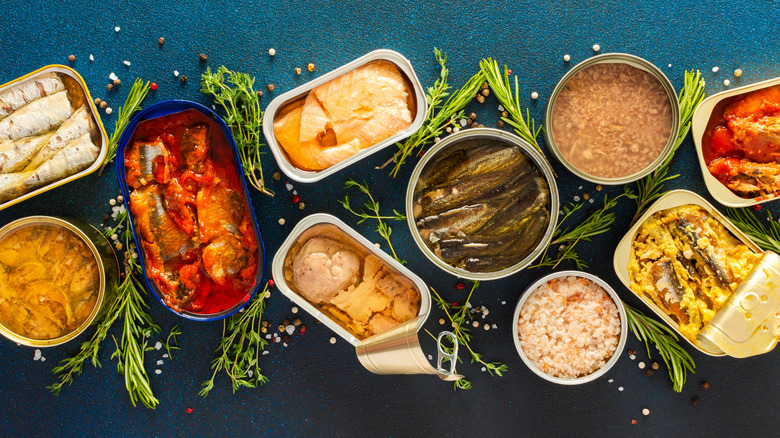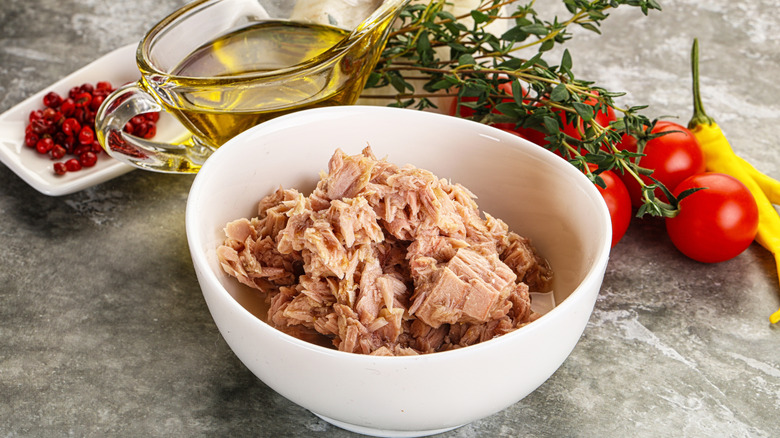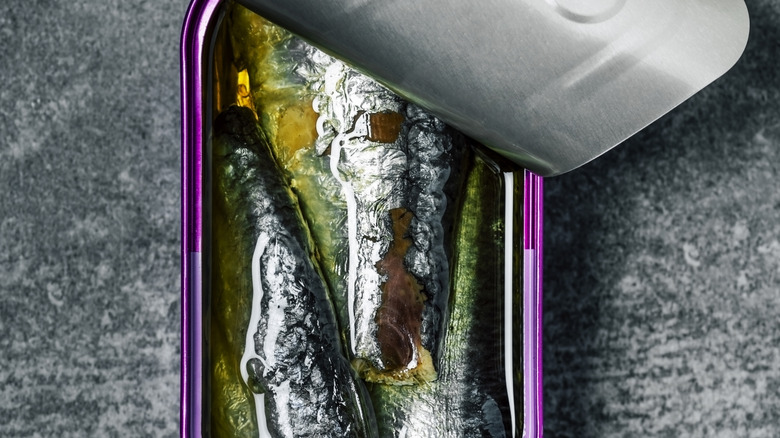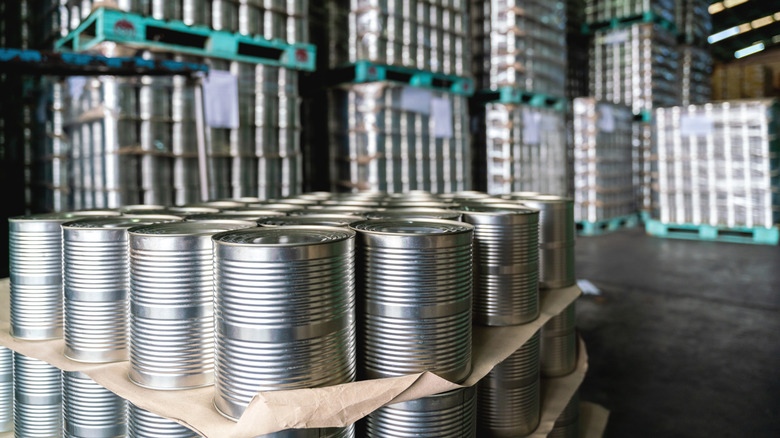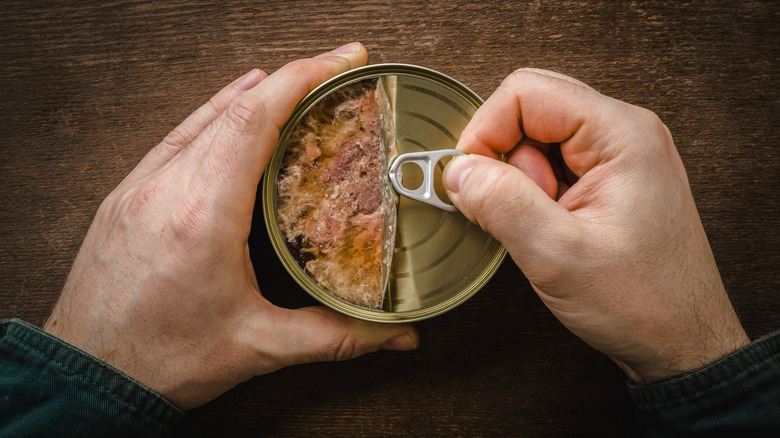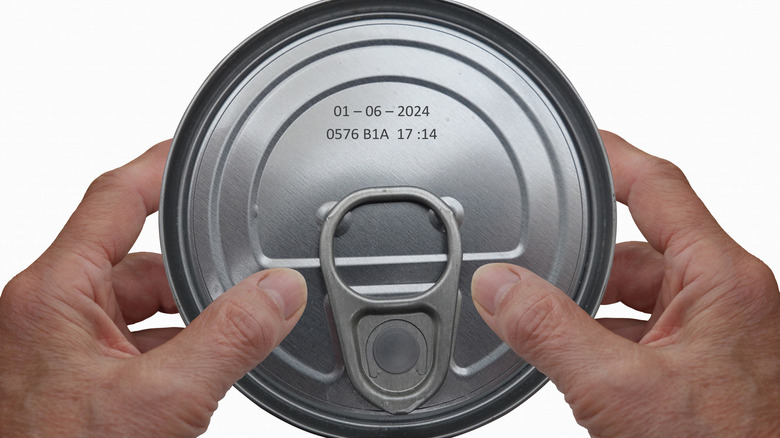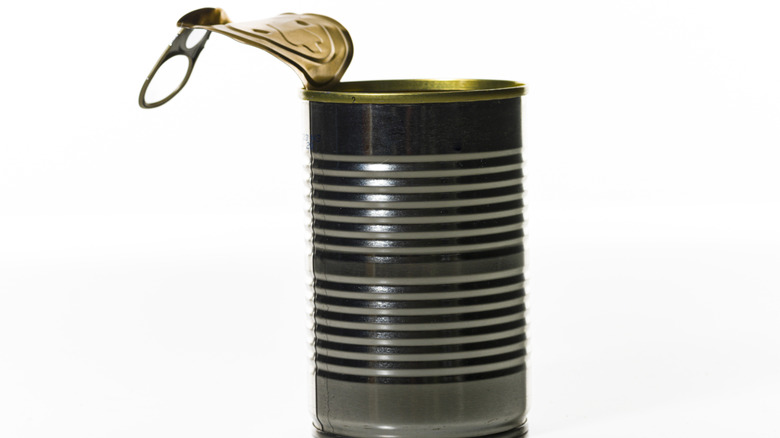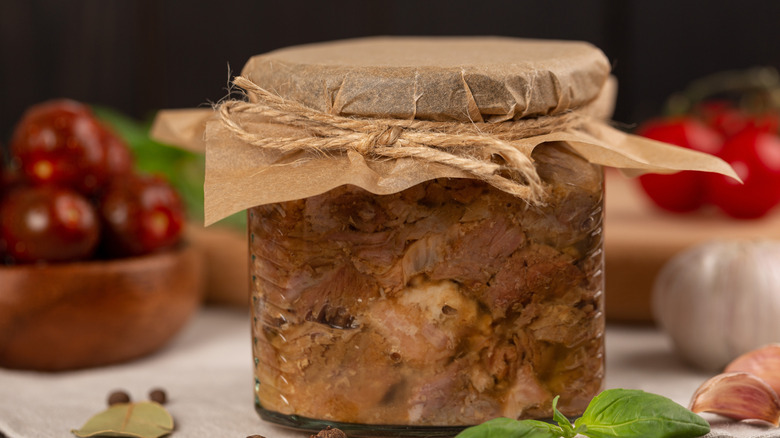9 Canned Meat Myths Everyone Keeps Falling For
Protein is the building block for conceptualizing meals for many of us. If you are short on time and can't cook meat on the fly, you likely have tried ready-made options that can be reheated to get that protein in. What may not come immediately to mind on a day-to-day basis is using canned meat. Not only are there more options than the popular canned meat SPAM, but the shelf-stable varieties of meat are ready to be consumed immediately, without firing up the grill or oven.
Whether it be canned tuna or seafood for salad, or chicken for a shortcut casserole, you would be surprised at how easy it can be to add protein to your meal without the lengthy cook time (and for a nominal price). However, canned meat has gotten a bad reputation for one reason or another. We found out the truth behind the myths about canned meat that are widely believed and have been so for years. Read on to become armed with knowledge as you find inspiration for your next meal in the pantry aisles of your grocery store.
1. Myth: Canned meat isn't as healthy as fresh food
One of the most prevalent myths that extends beyond meat into canned foods in general is the health factor. Many believe that canned food is a less healthy option compared to fresh varieties — but that isn't necessarily true. In fact, studies show fresh, frozen, and canned foods have a similar nutrient content overall, so it would be ideal to include all types for a well-rounded, healthy diet. Food is processed for canning at peak freshness. The timing is key, as food begins to break down after it is harvested. So the fact that meat is canned isn't necessarily an indicator of being "healthier" or "fresher" than other types of meat preparations.
It should be noted that some vitamins and nutrients may be negatively affected by the high heat required for canning, like vitamins B and C. However, some nutrients and antioxidants like lycopene and beta carotene become more prevalent through the canning process. Canned meats, in particular, can be considered a good source of protein, iron, and B vitamins – all necessary for your body to function properly. So next time you want a healthy, quick, protein-packed meal, don't frown on the canned tuna in your pantry!
2. Myth: Canned meat is full of preservatives and sodium
There are also myths about the specific nutrient profile of canned foods, including canned meat. Contrary to popular belief, canned meat isn't necessarily heavy on preservatives or sodium levels. In fact, canned food typically contains low sodium (or in some cases, none at all), resulting in it not even making it on the CDC's top 10 sources of sodium list. That's not to say that there aren't canned meats that are higher in sodium. Canned cured meats like corned beef or Vienna sausages are notorious for being higher sodium options. But you should be able to find low-sodium or no-sodium canned meat options. If you do find that your canned meat of choice is on the salty side, minimize the use of salt listed in a recipe or when seasoning yourself. You can also remove the excess salt from canned meat by rinsing it in a strainer. Rinsing the meat with hot water can also help eliminate excess fat, boosting the health content.
Canned food often doesn't have added preservatives. This is because the canning process takes a sealed can and utilizes high heat, which kills the microorganisms that cause contamination and spoilage. The process alone preserves the canned meat until it is opened — no excess preservatives needed.
3. Myth: The quality of canned meat is lackluster
It's safe to say that canned meats don't necessarily have the same wow-factor in presentation as their fresh or even frozen counterparts. However, there are many high-quality meat items that are served from the can. Pâtés and premium seafood options like eel and octopus are some examples of quality meats that you can find in the pantry aisle. You will likely find higher price points to match the higher-quality canned meats.
You can also count on different options of canned meats themselves to choose from, ranging from more budget options to higher-priced versions. Tuna packed in oil can provide an added richness and moisture for dishes if you don't plan to drain it before using. You will also find a variety of canned meat options like tuna, ranging from different taste profiles and textures to consider. The "quality level" is more of a personal preference in these cases, but it shouldn't be assumed that canned meats are lower quality than frozen or fresh meat. The canning process, which allows the meat to be shelf-stable, can make diverse and upscale imported options available to you. This means you may get to try $38 canned anchovies imported from the Bay of Biscay or tiny clams imported from Spain, without crossing the globe.
4. Myth: You can't substitute canned meat for fresh
Some culinary experts may turn their noses up at using canned meats over a butcher's special. However, it is totally possible to substitute canned meats in recipes for flavor or convenience. Canned meats like chicken are commonly used in recipes due to their versatile flavor profile and tender consistency. Dishes like tacos, casseroles, spaghetti sauce, soups, stews, or chilis lend themselves to using canned, pre-cooked meat. You can also add some extra ingredients to dishes with canned meat to kick up the flavor or improve the texture. Experts say adding panko breadcrumbs to patties made with canned meat like tuna can impart a coarser texture to what some would find almost too tender. Or if you love chicken pot pie, canned chicken can make a good substitution for fresh meat.
However, you may find some substitutions more successful than others. Some say that canned chicken can bring a metallic taste to pasta dishes, suggesting a rotisserie chicken as a shortcut. And while you may assume canned chicken is a perfect dip addition, if you plan to use the slow cooker, steer clear. The already-tender texture of canned chicken won't hold up as well as its fresh counterpart in a Buffalo chicken dip.
5. Myth: Canned meat is wasteful
This myth is for those who have environmental concerns at the forefront of their food decisions. When you see tons of canned goods stacked up in storage, you may think it equates to waste. But in reality, the canning process is actually considered eco-friendly. The canning process is more energy efficient than trying to transport and store chilled meats at the required temperatures for food safety. The cans themselves are often made from around 35% recycled steel. According to the American Iron and Steel Institute, the recycling rate for steel cans is 58%. Because of that, it can be debated that the recyclable aspect of canned meats causes less waste than plastic packaging for fresh meats at your grocery store's meat counter or in the ready-made food section. Metal cans of food can also be stacked easily, allowing more items in each truckload and limiting greenhouse gas emissions for multiple delivery trips.
Beyond the packaging, the canning process also cuts down on food waste. This is because canning lends itself to the utilization of imperfect foods by using cooking techniques like blanching or changing the presentation by chopping into smaller pieces instead of having them be thrown away. The process also allows inedible parts of food to be composted, if possible.
6. Myth: Canned meat isn't cooked
This myth is cause for confusion, as some believe that canned meat isn't cooked. But all canned meats are cooked during the canning process. The commercial canning process actually uses higher temperatures than what you would use to boil water, if that provides ease of mind. So, where did this myth come from? It could be the meat's appearance, as canned chicken may take on a pinker hue as if it is not cooked. However, that is not the case. According to the USDA, the pink color comes from chemical changes during cooking, as hemoglobin in the meat tissues reacts to the gases in ovens. It can vary across different birds depending on whether they are younger or older, or if preservatives are introduced into their diet through feed or water supply.
But just because the canned meat is already cooked doesn't mean you can't reheat it for appearance or texture reasons. You will want to be mindful of how long you reheat, though, to prevent further breakdown which can impact the texture. It is also best practice to read the labels of your canned protein for specific preparation tips and for peace of mind.
7. Myth: You can't eat canned food after the sell-by or use-by date
This myth is one that you may choose to observe or ignore based on your personal comfort level. But surprisingly, the dates on canned foods may not be as imperative to follow. Experts say that canned food bought at the grocery store can be considered safe to eat for years, if the can isn't compromised. Some alarming signs could be if the can has bulging, rusting, or if there are deep dents near the seal of the can. These signs can point to the development of bacteria in the can, which should be thrown away immediately.
Even though you don't necessarily have to strictly observe the sell-by or use-by dates on your canned meats, there are some guidelines to follow for best quality. The United States Department of Agriculture says that low-acid foods like meat or gravy, also including soups or stews, should be kept up to five years from the date of purchase for the best quality. Higher-acid canned foods or home-canned foods have a shorter recommended shelf life of one year. Regardless of your expiration date, you will want to store your canned meats in a cool, dry place with stable temperatures of ideally under 85 degrees Fahrenheit. Avoid storing canned meats near the stove or under the sink to lessen the risk of spoilage.
8. Myth: Lead can leak into the food of open cans
Once upon a time, lead was a concern in cans used for canned goods. But consumers don't need to worry about lead seeping into their food, as the U.S. Food and Drug Administration stopped using lead to solder cans in 1991, and fully banned the use of lead in food cans in 1995. This ban includes imported foods. Metal cans are now made of sheet steel, possibly with a tin coating, and welded closed. You may also find that your can has a protective coating of vinyl or enamel, providing another layer between the can and your food.
Even though lead is no longer a concern in cans, there still is some hesitancy to store leftover meat in an open can in the fridge. While it is safe to use the metal container for storage, you may notice a difference in your food's flavor or color. Some have commented that there is a certain metallic taste in the food after it is stored in the open can. Because of that, it is recommended to put the unused meat in another type of covered container that is not metal to avoid this. You also want to be sure to use the leftover canned meat within five days, or put it in the freezer.
9. Myth: You shouldn't can your own meat
Canning your own meat is a possibility if you do so safely. Canning meat at home is particularly popular in the homesteading community to preserve and store large amounts of protein for winter or for people who want ready-made dinner options. When done correctly, the meat is fully cooked, tender, and can be eaten from the jar or added to dishes. Pressure canning is the only research-based method that is deemed safe for canning meat, fish, or poultry at home. Other methods used for canning lower acid foods, like boiling water or steam canners, are unsafe, as the bacteria that cause botulism (Clostridium botulinum), are able to survive those canning temperatures. Time is also of the essence. Fresh, home-slaughtered meats should be chilled and canned as quickly as possible.
If you decide to can your own meat, you will want to be mindful that you properly handle your food during the canning process. Botulism is more common in home canning, and rarely happens in canned goods that are commercially packaged.
